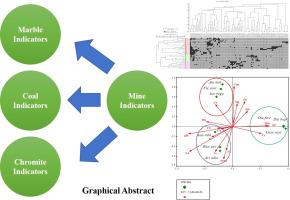Journal of Advanced Research ( IF 10.7 ) Pub Date : 2021-10-18 , DOI: 10.1016/j.jare.2021.10.005 Zeeshan Ahmad 1 , Shujaul Mulk Khan 1 , Sue Page 2 , Saad Alamri 3 , Mohamed Hashem 4

|
Introduction
There has been limited research conducted on the identifications/methodological approaches of using plant species as indicators of the presence of economically, important mineral resources.
Objectives
This study set out to answer the following questions (1) Do specific plant species and species assemblages indicate the presence of mineral deposits? and (2) if yes, then what sort of ecological, experimental, and statistical procedures could be employed to identify such indicators?
Methods
Keeping in mind these questions, the vegetation of subtropical mineral mines sites in northern Pakistan were evaluated using Indicator Species Analysis (ISA), Canonical Correspondence Analysis (CCA) and Structural Equation Modeling (SEM).
Results
A total of 105 plant species belonging to 95 genera and 43 families were recorded from the three mining regions. CA and TWCA classified all the stations and plants into three major mining zones, corresponding to the presence of marble, coal, and chromite, based on Jaccard distance and Ward’s linkage methods. This comprehended the following indicator species: Ficus carica, Isodon rugosus and Ajuga parviflora (marble indicators); Olea ferruginea, Gymnosporia royleana and Dicliptera bupleuroides (coal indicators); and Acacia nilotica, Rhazya stricta and Aristida adscensionis (chromite indicators) based on calculated Indicator Values (IV). These indicators were reconfirmed by CCA and SEM analysis.
Conclusion
It was concluded that ISA is one of the best techniques for the identification/selection of plant indicator species, followed by reconfirmation via CCA and SEM analysis. In addition to establishing a robust approach to identifying plant indicator species, our results could have application in mineral prospecting and detection.
中文翻译:

植物预测矿产——使用指示植物物种发现矿区的方法论
介绍
关于使用植物物种作为经济上重要矿产资源存在的指标的鉴定/方法学方法的研究有限。
目标
本研究旨在回答以下问题(1)特定植物物种和物种组合是否表明存在矿藏?(2) 如果是,那么可以采用什么样的生态、实验和统计程序来确定这些指标?
方法
牢记这些问题,巴基斯坦北部亚热带矿产地的植被使用指标物种分析 (ISA)、典型对应分析 (CCA) 和结构方程模型 (SEM) 进行了评估。
结果
三个矿区共记录植物95属43科105种。CA 和 TWCA 根据 Jaccard 距离和 Ward 联动方法将所有站点和工厂分为三个主要采矿区,对应于大理石、煤和铬铁矿的存在。这包括以下指示物种:Ficus carica、Isodon rugosus和Ajuga parviflora(大理石指示物);Olea ferruginea、Gymnosporia royleana和Dicliptera bupleuroides(煤指标);和尼罗金合欢 _ _和Aristida adscensionis(铬铁矿指标)基于计算的指标值 (IV)。CCA和SEM分析再次证实了这些指标。
结论
得出的结论是,ISA 是识别/选择植物指示物种的最佳技术之一,其次是通过 CCA 和 SEM 分析再次确认。除了建立一种可靠的方法来识别植物指示物种外,我们的结果还可以应用于矿产勘探和检测。



























 京公网安备 11010802027423号
京公网安备 11010802027423号